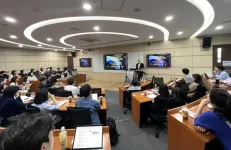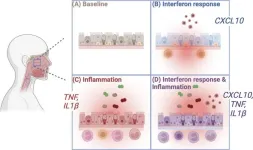(Press-News.org) Politicians around the world are increasingly mobilizing anti-immigrant sentiment to garner support and votes—a trend that is especially evident as the US presidential election approaches.
While political rhetoric that stereotypes and scapegoats immigrants is well-documented, less attention has been given to the impact of these sentiments on immigrants themselves. In an article published today in the Journal of the American Medical Association (JAMA) and in a recently published book, Migration Stigma (MIT Press), scholars identify “migration stigma” as a pervasive and destructive force that links responses to immigration—such as prejudice and politics—to the health of immigrants.
“This concept of ‘migration stigma’ for the first time pulls together phenomena like the politicization of immigration and goes beyond how the native born think of immigrants to consider how it influences physical and mental health,” said Lawrence Yang, professor and chair of the Department of Social and Behavioral Sciences at NYU School of Global Public Health, first author of the JAMA article, and lead editor of Migration Stigma.
The human cost
In the JAMA article, the authors write that being labeled as a migrant can set off a cascade of negative consequences: stereotyping, separation or “othering,” discrimination, and loss of social status. In the context of power dynamics, these factors together result in stigma.
Stigma can take different forms, but all risk harming the health and mental health of immigrants. One form, structural stigma, occurs when groups are treated differently by laws or policies based on their status. For immigrants, this may mean worse access to education, housing, health care, and jobs—all of which are powerful social determinants of health, or social and structural factors that influence health outcomes.
Other forms of stigma may be less obvious. For instance, immigrants and their descendants who are attuned to the negative political environment and stereotypes people hold about immigrants may feel shame and internalize these negative beliefs.
Internalized stigma can increase stress, which may lead to a host of mental health issues, including anxiety, depression, and sleep disorders, and can even exacerbate post-traumatic stress disorder (PTSD) among migrants who endured traumatic journeys across borders. Moreover, internalized stigma—coupled with the fear of deportation—may deter immigrants from seeking medical attention and other services that ultimately improve their health and life opportunities, including jobs and education.
“New immigrants who are aware that the US is not the most hospitable place right now may respond to this negative environment by inadvertently avoiding opportunities to maintain their health,” said Yang, who is also the founding director of the Global Mental Health and Stigma Program at the NYU School of Global Public Health.
Addressing migration stigma
“A new focus on the intersection of migration and stigma creates an opportunity to break the cycle of harmful policies and rhetoric that fuel stigma and hurt the health of immigrants and others,” Yang said. And because stigma involves many factors—labeling, stereotyping, “othering,” and loss of status—interventions to reduce stigma can work to address any of these linkages.
“For instance, we can introduce new narratives to change a label or address stereotyping, or can encourage policymakers to enact anti-discrimination laws to preserve access to health care and education,” added Yang.
The authors also write in JAMA that to avoid stigmatizing migrant patients, health professionals can recognize that health and illness stem from social, political, and economic structures.
A new field of research
The concept of migration stigma grew out of an international forum, convened by the Ernst Stüngmann Foundation, that brought together scholars in the fields of stigma and migration to explore connections between the two.
“Although both fields examine the causes and consequences of prejudice and discrimination, until recently there was little formal collaboration between stigma and migration scholars,” said Yang.
Through this process, the scholars coined the concept of migration stigma and launched this new field of research. Future areas of study include the impact of the migrant label on different life domains, whether the label extends beyond migrants themselves to other generations or associated racial or ethnic groups, and whether stigma has long-term health consequences.
“By examining how the seemingly disparate phenomena of anti-immigrant politics and individuals’ health are related, we enhance the possibilities for researchers and clinicians to understand, and ideally, intervene to promote public health,” the authors write in JAMA.
The JAMA article was co-authored by Bruce Link of UC Riverside and the Columbia Mailman School of Public Health and Maureen Eger of Umeå University and the Center for Right-Wing Studies at UC Berkeley. Eger and Link are also the co-editors of the book.
END
How politicizing migration harms health
During a period of heightened global migration, researchers articulate the human cost of anti-immigrant rhetoric and the role of “migration stigma” in health
2024-07-01
ELSE PRESS RELEASES FROM THIS DATE:
Excess US deaths attributable to high all-cause mortality rates among youths
2024-07-01
About The Study: The mortality gap between the U.S. and comparison countries widened in the last decade. Each year, nearly 20,000 deaths among youths ages 0 to 19 years would not have occurred had U.S. youths experienced the median mortality rates of 16 comparison countries. More than half of these deaths involved infants, reflecting disproportionately high U.S. infant mortality rates.
Corresponding Author: To contact the corresponding author, Steven H. Woolf, M.D., M.P.H., email steven.woolf@vcuhealth.org.
To access the embargoed study: Visit our For The Media website at this link https://media.jamanetwork.com/
(doi:10.1001/jamapediatrics.2024.1869)
Editor’s ...
COVID-19 vaccination in the first trimester and major structural birth defects among live births
2024-07-01
About The Study: Among live-born infants, first-trimester mRNA COVID-19 vaccine exposure was not associated with an increased risk for selected major structural birth defects in this multisite cohort study.
Corresponding Author: To contact the corresponding author, Elyse O. Kharbanda, M.D., M.P.H., email elyse.o.kharbanda@healthpartners.com.
To access the embargoed study: Visit our For The Media website at this link https://media.jamanetwork.com/
(doi:10.1001/jamapediatrics.2024.1917)
Editor’s Note: Please see the article for additional ...
Dehumanizing rhetoric on immigration harms public health
2024-07-01
With Donald Trump and other right-wing politicians increasingly using dehumanizing rhetoric to stigmatize immigrants coming to our nation's borders, doctors and other health officials should prepare for the resulting health consequences.
Such is the message of a “Viewpoint” article co-authored by UC Riverside professor Bruce Link and published Monday, July 1, in the Journal of the American Medical Association.
Link and his co-authors quote Trump as saying, “No, they’re not humans. They’re not humans. They’re ...
A prosthesis driven by the nervous system helps people with amputation walk naturally
2024-07-01
State-of-the-art prosthetic limbs can help people with amputations achieve a natural walking gait, but they don’t give the user full neural control over the limb. Instead, they rely on robotic sensors and controllers that move the limb using predefined gait algorithms.
Using a new type of surgical intervention and neuroprosthetic interface, MIT researchers, in collaboration with colleagues from Brigham and Women’s Hospital, have shown that a natural walking gait is achievable using a prosthetic leg fully driven by the body’s own nervous system. ...
Novel blood test helps improve cancer treatments
2024-07-01
The earlier a cancer is detected, the better the chances that treatment will be effective. This applies to almost all types of cancer. Another crucial element in successfully treating patients is to individually assess the benefits and risks of individual forms of therapy and to regularly monitor treatment success. To do this, oncologists have a range of methods at their disposal, most notably imaging technology and invasive measures such as tissue biopsies, punctures and endoscopic procedures.
Analyzing gene fragments in the bloodstream
Researchers ...
Research-driven Korea University College of Medicine promotes joint research with global scholars
2024-07-01
Korea University's College of Medicine (Dean Pyun, Sung Bom) hosted the 1st Research Nexus Program in order to enhance international research network cooperation and vitalize global joint research.
This program shares the latest research trends and aims to invigorate international joint research by opening a seminar inviting top global scholars to promote international research performances.
The 1st program held an invitation seminar of Prof. Jeffrey D. Macklis, the "global authority in the field of neurogenesis" (Department of Stem Cell and Regenerative Biology at Harvard University).
Prof. Macklis ...
Degradation of cell wall key in the spread of resistance
2024-07-01
A study at Umeå University, Sweden, provides new clues in the understanding of how antibiotic resistance spreads. The study shows how an enzyme breaks down the bacteria's protective outer layer, the cell wall, and thus facilitates the transfer of genes for resistance to antibiotics.
"You could say that we are adding a piece of the puzzle to the understanding of how antibiotic resistance spreads between bacteria," says Ronnie Berntsson, Associate Professor at Umeå University and one of the authors behind the study.
The Umeå researchers have studied Enterococcus faecalis, which is a bacterium that often ...
The evidence is mounting: humans were responsible for the extinction of large mammals
2024-07-01
The debate has raged for decades: Was it humans or climate change that led to the extinction of many species of large mammals, birds, and reptiles that have disappeared from Earth over the past 50,000 years?
By "large," we mean animals that weighed at least 45 kilograms – known as megafauna. At least 161 species of mammals were driven to extinction during this period. This number is based on the remains found so far.
The largest of them were hit the hardest – land-dwelling herbivores weighing over a ton, the megaherbivores. Fifty thousand years ago, there were 57 species of megaherbivores. Today, only 11 remain. These remaining ...
Common respiratory infections may have protected children from COVID-19, study suggests
2024-07-01
Analyzing nasal swabs taken during the pandemic, researchers at Yale School of Medicine suggest that the frequent presence of other viruses and bacteria may have helped to protect children from the worst effects of COVID-19 by boosting their immune systems. Their results will be published July 1 in the Journal of Experimental Medicine (JEM).
Children are generally more susceptible than adults to respiratory infections such as the common cold, and yet, for unknown reasons, the SARS-CoV-2 virus tends to cause less severe ...
Ochsner Medical Center – Baton Rouge performs robotic-assisted lung biopsy
2024-07-01
BATON ROUGE, La. – Ochsner Medical Center – Baton Rouge now offers robotic-assisted bronchoscopy using the Ion robotic platform, a new, minimally invasive option for lung biopsy.
With bronchoscopy, doctors insert a long, thin tube with a camera to examine lung tissue and retrieve a biopsy sample. The Ion robot enables doctors to perform a biopsy quicker and safer than ever before.
These advancements are especially critical for treating lung cancer, since early detection is key to achieving the best outcome. Every six weeks of delayed treatment lowers ...
LAST 30 PRESS RELEASES:
Crystallographic engineering enables fast low‑temperature ion transport of TiNb2O7 for cold‑region lithium‑ion batteries
Ultrafast sulfur redox dynamics enabled by a PPy@N‑TiO2 Z‑scheme heterojunction photoelectrode for photo‑assisted lithium–sulfur batteries
Optimized biochar use could cut China’s cropland nitrous oxide emissions by up to half
Neural progesterone receptors link ovulation and sexual receptivity in medaka
A new Japanese study investigates how tariff policies influence long-run economic growth
Mental trauma succeeds 1 in 7 dog related injuries, claims data suggest
Breastfeeding may lower mums’ later life depression/anxiety risks for up to 10 years after pregnancy
Study finds more than a quarter of adults worldwide could benefit from GLP-1 medications for weight loss
Hobbies don’t just improve personal lives, they can boost workplace creativity too
Study shows federal safety metric inappropriately penalizes hospitals for lifesaving stroke procedures
Improving sleep isn’t enough: researchers highlight daytime function as key to assessing insomnia treatments
Rice Brain Institute awards first seed grants to jump-start collaborative brain health research
Personalizing cancer treatments significantly improve outcome success
UW researchers analyzed which anthologized writers and books get checked out the most from Seattle Public Library
Study finds food waste compost less effective than potting mix alone
UCLA receives $7.3 million for wide-ranging cannabis research
Why this little-known birth control option deserves more attention
Johns Hopkins-led team creates first map of nerve circuitry in bone, identifies key signals for bone repair
UC Irvine astronomers spot largest known stream of super-heated gas in the universe
Research shows how immune system reacts to pig kidney transplants in living patients
Dark stars could help solve three pressing puzzles of the high-redshift universe
Manganese gets its moment as a potential fuel cell catalyst
“Gifted word learner” dogs can pick up new words by overhearing their owners’ talk
More data, more sharing can help avoid misinterpreting “smoking gun” signals in topological physics
An illegal fentanyl supply shock may have contributed to a dramatic decline in deaths
Some dogs can learn new words by eavesdropping on their owners
Scientists trace facial gestures back to their source. before a smile appears, the brain has already decided
Is “Smoking Gun” evidence enough to prove scientific discovery?
Scientists find microbes enhance the benefits of trees by removing greenhouse gases
KAIST-Yonsei team identifies origin cells for malignant brain tumor common in young adults
[Press-News.org] How politicizing migration harms healthDuring a period of heightened global migration, researchers articulate the human cost of anti-immigrant rhetoric and the role of “migration stigma” in health




